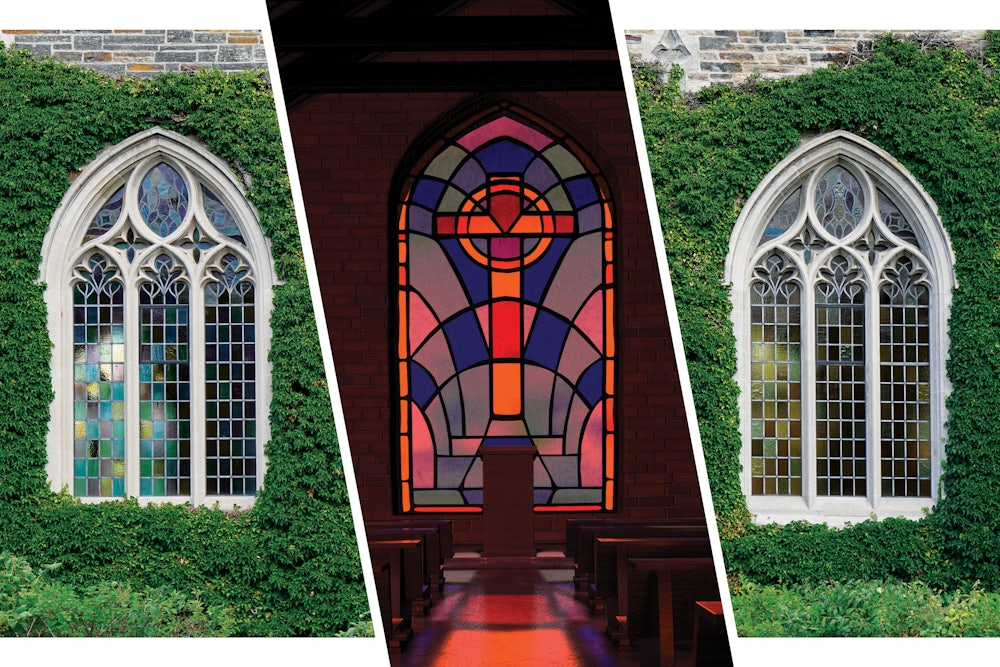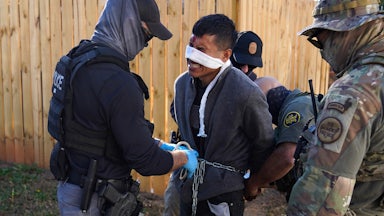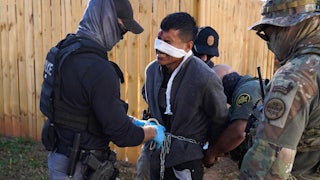Trump and his allies are betting that their assault on academia will bring a political win, no matter the economic pain or courtroom outcomes. Based on the polls, they may be right. Last year, according to Gallup, only 36 percent of Americans said they had a “great deal” or “quite a lot” of confidence in higher education—down about 20 points since 2015.
Churches have a similar PR problem. About the same proportion of Americans say they place significant confidence in organized religion (down from roughly 60 percent a generation ago). In the decades since the Vietnam War, Americans’ faith in all kinds of big institutions has collapsed.
But recent data has brought a twist: Churches are enjoying a small but significant rebound, especially among young people. Maybe these millennials and Zoomers have hit peak exhaustion with the meaninglessness of TikTok scrolling. Maybe the young men among them are seeking an alternative to the secular media’s message that they are guilty of “toxic masculinity” until proven innocent.
In an era when the White House press secretary announces a funding freeze on “wokeness” while flaunting a giant cross necklace, it’s easy to assume that traditional Christianity and secular academia are permanent enemies, on opposite sides of some civilizational chasm. But in fact, the fates of churches and universities have long been intertwined. For academics grappling with how to regain public trust, there are surprising lessons in the recent Christian resurgence—and, perhaps, a counterintuitive strategy for turning the current campaign to cripple and humiliate universities into an occasion to recover core ideas about the purpose of higher education.
In the two decades after World War II, churches and universities both cruised at the zenith of cultural influence. Americans were inclined to trust experts, whether they preached from a pulpit or lectured in front of a blackboard. It can be hard to imagine now, but back then nerdy theologians like Reinhold Niebuhr, Paul Tillich, and Henry P. Van Dusen graced the cover of Time, and Democratic presidential campaigns bought splashy ads in The New York Times to show off endorsements they received from university professors. Even Republicans courted the support of university “eggheads.” During the 1960 presidential election, the Republican National Committee—envious of John F. Kennedy’s “Brain Trust”—recruited a Stanford political scientist named Cornelius P. Cotter to convince more faculty that the Republican Party was a “serious intellectual enterprise,” Cotter told reporters.
It’s important not to romanticize the intellectual’s status in the shadow of God and Man at Yale and Joseph McCarthy’s fulminations. But even historian Richard Hofstadter—author of Anti-Intellectualism in American Life and the reigning expert on the subject—expressed relief that “Washington has again become so hospitable to Harvard professors and ex-Rhodes scholars.”
The theologians and secular intellectuals who had the respect of average Americans and the political class wrote books and articles that sometimes criticized their country. But they were not cynics. They did not interpret every action by opponents as purely a self-interested power grab, and they did not think of their main professional duty as helping laypeople see the world through a hermeneutic of suspicion. Many had served in combat or government administration during wartime and retained a core confidence in the American project. “We cannot make democracy a fighting faith merely by exhortation nor by self-flagellation…. we must somehow dissolve the anxieties which drive people in free society to become traitors to freedom,” the historian Arthur M. Schlesinger Jr. wrote in 1949.
This spirit of critical patriotism extended into the classroom. After World War II, colleges nationwide drew inspiration from Harvard’s 1945 report, General Education in a Free Society, which recommended assigning “great classic books” to help students “reconcile the sense of pattern and direction deriving from heritage with the sense of experiment and innovation deriving from science.” The point was to study history, philosophy, and literature with an eye toward the long time horizon of a civilization rather than the immediate demands of the job market or election cycle. Yes, American universities were helping to fight the Cold War by focusing research on the space race and other military applications (thanks to unprecedented levels of federal funding). But they also nurtured a counterculture: not in the sense of a political underground, but in resistance to utilitarian pressures to define “useful skills” narrowly.
Today, by contrast, many academics—especially humanists—have adopted pedagogies and research methods based on critique, cynicism, and deconstruction. Many lack the credibility and perspective that come with time in a military uniform or government service. In a series of autobiographical essays by retired Yale faculty published recently by the university, veterans dominated the older entries; their numbers dropped to nearly zero among recent retirees. Instead, many wrote about avoiding the Vietnam draft. Professors, like other Americans, lost trust in institutions.
That loss of trust has gradually extended to their own institutional homes, the universities themselves—especially as vocational majors like communications, exercise science, and engineering have won over student interest and administration support. In an effort to cope with the resulting crisis of purpose—and feeling, increasingly, like the have-nots of the academic prestige hierarchy—some humanists have found a new identity in the culture-war tendency to politicize all parts of life and deem certain academic methods and topics ideologically unacceptable.
The problem was never the presence of left-wing dissent in academia. Professors at secular universities have long leaned left. The problem was that, over time, elite universities made cynical critique the marker of original scholarship and adopted a narrow idea of what counts as countercultural “life of the mind.”
The term should describe a space that questions the values and practices of the dominant society from every angle, not just political ones. A university should provide a haven for unfashionable ideas and practices in the broadest sense: a home for reading long books, studying dead languages, questioning popular slogans, and taking the long-range view in a society that emphasizes immediate returns. These practices require a certain confidence in your civilization and in the university as an institution—a faith that you exist in a community with old things worth preserving and mighty goals worth striving for.
Liberal Christian denominations made the same error that the universities did. They let self-criticism turn into self-hatred and forgot what it is to be a real counterculture. In the late 1960s and 1970s, these churches saw membership decline partly because they began to substitute this-worldly politics for Christianity’s supernatural inversion of the universe. Why bother attending a liberal Methodist church or a Reform synagogue when you can join your local Democratic Party mailing list with a lot less effort?
Conservative churches made an idol out of politics as well. But their continued emphasis on Christianity’s ancient, supernatural core helped them thrive until the twenty-first century, when they could no longer resist the anti-institutionalist current in American culture. Membership in Southern Baptist churches, for example, has shrunk by nearly a quarter in the past two decades.
Yet today, something is shifting. Southern Baptist membership is still down from its 2006 peak of 16.3 million, but the denomination’s church attendance and baptisms have grown over the last two years. The number of Americans who reject religious affiliation no longer seems to be rising. One survey showed that 69 percent of college-educated men age 40 and under claim a religious affiliation—up 10 points since 2022, and 7 points higher than women in the same demographic. (One obvious lesson for universities: pay more attention to young men. Nationwide, they are less likely than women to start college, less likely to graduate, and on track to become the largest underrepresented group in academia.)
It’s too early to speak of full-fledged revival, but this upswing in religious engagement offers lessons for universities. The churches that seem to be rebounding are the ones that embrace countercultural aspects of Christianity. These Roman Catholic, Eastern Orthodox, Anglican, and Holy Spirit–minded Protestants are not the Christians who spent the last century trying to update “premodern” beliefs to fit the demands of Western progressivism and scientism. They don’t shy away from outrageous supernatural claims, or rituals that puzzle outsiders, or traditional teachings on sexuality and gender.
Universities need to be more like these churches: not more politically conservative, but less cynical and more countercultural. In recent years, too many colleges have sidelined the study of difficult books in favor of shorter, “low-stakes” assignments that capitulate to students’ shrinking attention spans. They have shaped general education requirements in response to student consumerism and faculty hyper-specialization, so “gen eds” amount to a smattering of unrelated courses on boutique subjects that give students no sense of anchoring concepts like the rule of law, or the values of the liberal tradition.
We have unwittingly undermined our side of the academic social contract, which used to promise students intellectual experiences that they could find nowhere else: a chance to gain broad perspective on their communities, and the invitation to form their own judgments about questions of ultimate concern. When the AI revolution came along and offered students a shortcut, a way to simulate their side of the contract without learning or thinking very much, it’s no wonder they took it. And when the Trump administration began insisting that the highest goal that most universities aim for is a baldly partisan one, many Americans believed it.
The best way to prove universities’ value is to get countercultural again. Innovation and job preparation are part of their mandate—but so is preserving “old-fashioned” disciplines and ideas. That means defending inefficient, human-centered learning: strange and premodern practices such as reading an old book, then writing a long essay about it. When universities replace education with training sessions in how to write ChatGPT prompts, and when they hire faculty who overwhelmingly share the same political beliefs, they adopt the very patterns in mainstream culture that they ought to resist. (If you think that evangelicals’ support for Trump at a rate of around 75 percent in the last election makes them a political monoculture, the homogeneity in academia is far more extreme: Only 3.6 percent of tenure-track social scientists at research universities lean right.)
Repairing universities’ eroded culture, community, and mission is the work of a generation. But there is one radical act that professors and students can undertake right now: sit in a room together, put everyone’s phones in a shoebox, and spend at least an hour reading a book, in hard copy. In other words, restore counterculture to the classroom, and remember that “our subject is a vast one—since it concerns the totality of human experience,” as Dexter Perkins, the president of the American Historical Association, told his colleagues in 1956. He hoped their students would become “neither cynics nor visionaries but well-balanced citizens”—citizens who learn to see, one hopes, the difference between reforming institutions and destroying them.




